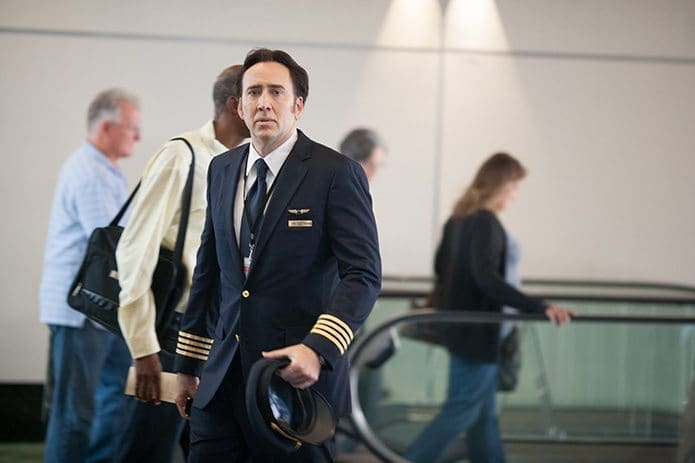 CNS photo/Teddy Smith, courtesy Stoney Lake Entertainment
CNS photo/Teddy Smith, courtesy Stoney Lake Entertainment New York
‘Left Behind,’ first in trilogy, weaves fiction with rapture theology
By KURT JENSEN, Catholic News Service | Published October 17, 2014
NEW YORK (CNS)—The fundamentalist conception of the rapture, as described in the best-selling “Left Behind” novels, may be arriving—for the first time—at a movie theater near you.
Three earlier films, all starring Kirk Cameron, were marketed primarily as home videos, though the first did have a limited theatrical release. They never drew as large an audience as the series of 16 apocalyptic volumes from authors Tim LaHaye and Jerry B. Jenkins that began in 1995.
The reboot is the first in a planned trilogy of pictures from Stoney Lake Entertainment. Director Vic Armstrong says Nicolas Cage, who plays faith-averse airline pilot Rayford Steele, is expected to appear in all of them. Additional star power in the initial outing comes from Lea Thompson, Chad Michael Murray, Nicky Whelan and Jordin Sparks.
Like both its print and screen predecessors, the new “Left Behind” interweaves a fictional narrative with rapture theology.
As presented in the movie, the latter asserts that the return of Jesus Christ to earth will be preceded by a seven-year period of tribulation. Christian believers, however, will be spared the global catastrophes of this era because they will have been “raptured up” to heaven.
“No one was happy” with the first series of films, Armstrong says, particularly LaHaye. This time, he adds, everyone thinks they got it right, with more of an emphasis on the “adventure story.”
“We didn’t want to stuff anything down anyone’s throat,” says Armstrong, a former stunt man and stunt coordinator. “We didn’t want to make a preachy movie. It’s a fine line to walk, to get it right.”
Believers in rapture doctrine focus on Bible verses that they maintain predict the end times with some precision.
There are few specific references to these in the new film. In the opening minutes, a character asks if anyone has read Chapter 24, Verse 7 of the Gospel of St. Matthew, a verse in which Jesus speaks of wars, famines and earthquakes. All these things, the next verse states, are “the beginning of the labor pains.” Jesus’ discourse comes in response to his disciples’ request for the signs of his return.
Catholic theologians have long been concerned by the novels, which veer away from Catholic beliefs specifically—and mainstream Christian ones more generally.
“A seven-year tribulation between the ‘rapture’ and the return of Christ is not biblical,” Catholic religious educator Joyce Donahue wrote in 2004. “Scripture teaches that Christ will come after a period of tribulation and that all believers will at that time be taken up to heaven to be with him.” Donahue also criticized the “harsh, judgmental” view of God in the novels.
Rapture theology delineates three distinct advents of Christ: First, his physical birth in Bethlehem; second, his secret return to “rapture up” Christian believers before the end times, and third, his appearance in majesty at the end of the world.
Catholic teaching, by contrast, maintains that Christ’s return in glory will be his second coming, not his third.
None of this, Armstrong says, concerned the actors while the film was being made. Filmmaking, being “quite a clinical process,” he doesn’t think many of them understood the theological underpinnings when they signed up. Eventually, though, “everyone did their homework.”
Cage, he says, focused more on the personal drama of Steele’s troubled marriage. “He has a very, very warm heart. He related to a lot of the situations.”
One of Cage’s few public comments about the film was given to The Christian Post: “If you look at my filmography there’s no secret to the fact I am drawn to movies that aren’t afraid to take on spiritual themes.
“Without going into my own personal spirituality, which is very sacred to me and not for public consumption or meant to be put in the media, I like to let my work speak for me. I like to find movies that allow me to explore these inner or outer worlds through the work without me having to really talk too much about it.”
“Left Behind” (Freestyle)
A journalist (Chad Michael Murray), a pilot (Nicolas Cage) and the flyer’s daughter (Cassi Thomson) struggle to cope with the disastrous results when millions of people spontaneously disappear in “The Rapture,” an event some believe will precede the Second Coming of Christ. Catholic viewers will likely feel left out by director Vic Armstrong’s screen version of the first in a series of novels by Tim LaHaye and Jerry B. Jenkins since the underlying interpretation of the Apocalypse on which the film is based is at odds with church teaching on the subject. Given the tedious nature of this low-rent drama, though, they won’t be missing much. Themes requiring a solid grounding in faith, pervasive mayhem with brief gore, drug use, a single crude term. The Catholic News Service classification is A-III—adults. The Motion Picture Association of America rating is PG-13—parents strongly cautioned. Some material may be inappropriate for children under 13.